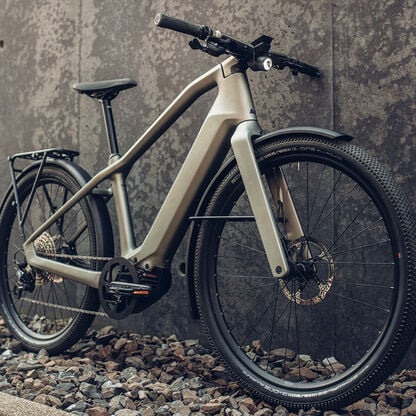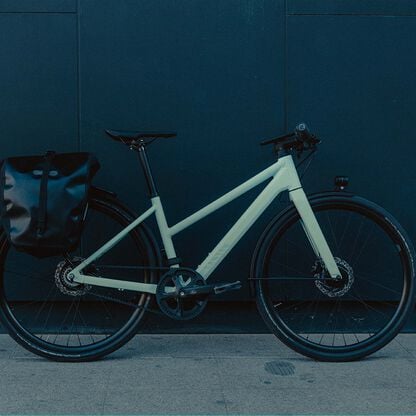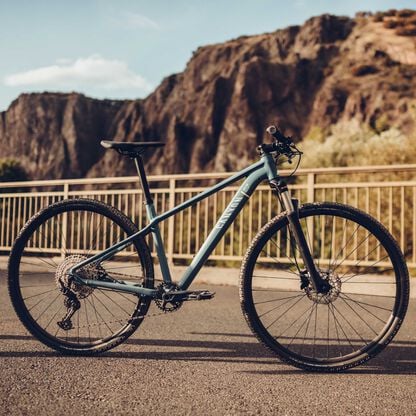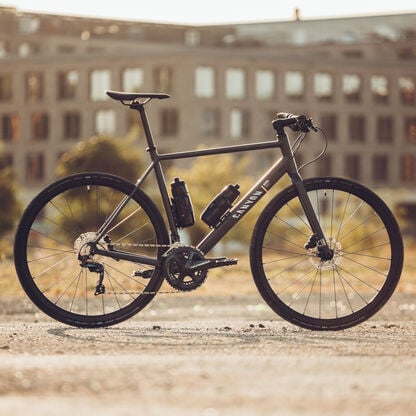The Ultimate Guide to Commuting by Bike
Want to save money, do your bit for the environment and improve your health? Commuting by bike is the answer. Our ultimate guide tells you all you need to know for getting to and from work by bike.

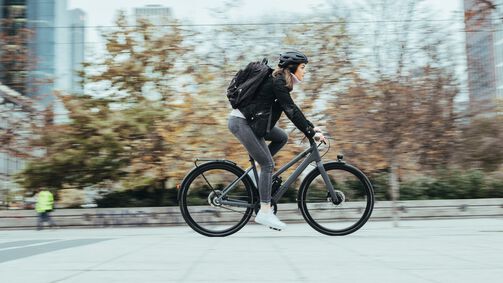
Have you ever sat in traffic on the way to work looking on in envy at the people on bikes zipping ahead while you sit watching the minutes pass by? If the thought of having a go at commuting by bike has crossed your mind for even a split second, it’s time to think no more and get going.
Commuting by car in the busiest UK cities sacrifices time you could be spending doing the things you love. Commuters across the country are spending up to 200 hours a year stuck in traffic. What would you do with an extra three hours a week?
We love cycling - that’s no secret - but more than that, we want you to love it too. Cycling to and from work is one of the ways we can encourage you to experience the joy of riding a bike. We thought we’d gather all our expert knowledge and make a handy guide to explain everything you need to know about commuting by bike including the type of bike, all the gear you need and a few route planning tips.
Let’s get started...
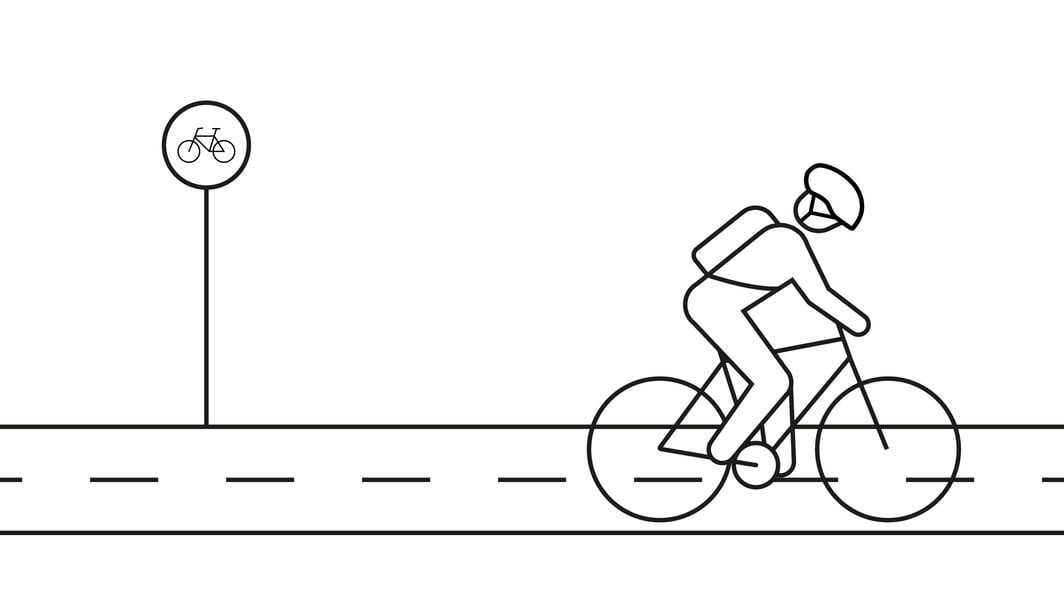
Why should you commute by bike?
Imagine getting some daily exercise, avoiding traffic or crowded public transport, saving money and looking after the environment. Well, imagine no more because you can do it all on your bike on the way into work.
Get fitter and feel great
If you ride to and from work, you will incorporate your daily exercise at either end of your day. Cycling is a great cardio workout and will set you up for the rest of the day. Even an E-bike can help you improve your fitness at the same time as giving you a boost when you need it most.
As well as the physical benefits of riding a bike, studies have shown that exercise improves mental wellbeing. Getting those precious minutes to yourself on the bike gives you time away from your desk, steering wheel or crammed bus or train. It’s time for you to think, breathe and focus on riding your bike.
When you arrive at work, the chances are your mood will be lifted and you’ll be a happier and more productive person as a result.
Save money and time
For a lot of people, their commute is one of their highest outgoings every month. All the money spent on fuel, parking, insurance, vehicle registration, servicing and maintenance can go towards something better when you eliminate these costs.
The cost of season tickets on public transport, while cheaper than a car, is only ever going to get more expensive and let’s not mention delays and cancellations. You’re also at the mercy of timetables with public transport, which can restrict how flexible you can be with your time particularly if you live a bit further away from work.
After you’ve got your bike and kit, a bike is free to ride any time of the day or night. You might even find yourself picking up a few groceries on your way home because it’s easy.
Help the environment
We’re in the midst of a climate crisis and studies show that almost half of all car journeys are less than 5 km in distance. If those people replaced those 5 km trips with their bike, we’d quickly reduce the amount of CO2 in the atmosphere and the impact on the environment.
It’s a great feeling to know you powered yourself through your journey rather than relying on fossil fuels to get you to work. By switching your car for a bike, you’re making a positive difference and helping heal the environment.

What bike is best for commuting?
Put simply, you can commute on any bike you like however there will be one that suits your needs more than the next. You need to think about the type of riding you’ll do when you buy a bike and there is no right or wrong answer.
Do you want to ride on the weekends with your family? Do you want to use local bridleways and bike paths instead of the road? Is your commute long or hilly? Would you like to use the same bike for a few different jobs?
We’re sure to have a bike for you regardless of your experience or fitness level, so let’s take a closer look at some of our best bikes.
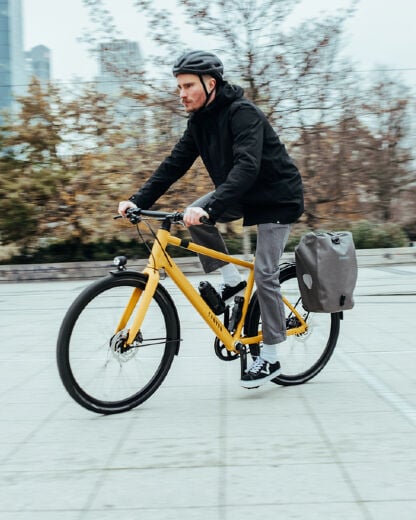
Commuting Bikes
A dedicated commuter bike is ideal if you plan to use the bike for getting into and out of town during the week. The flat handlebars, sleek aluminium frame and 40 mm tyres make it a comfortable and durable bike for every commute.
You can choose between a no-frills workhorse that you can rely on to get you to work and back or a fully-equipped bike with pannier racks, built-in lights and mudguards to more comfort and versatility.
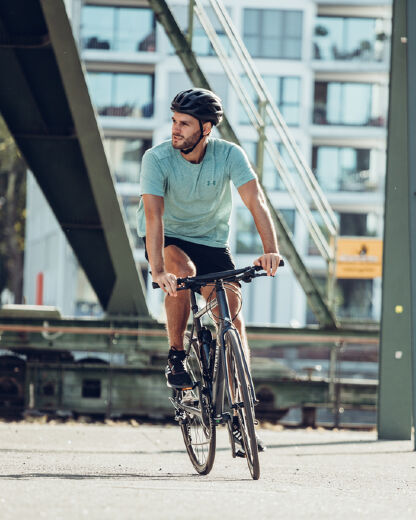
Hybrid Bikes
Like commuting bikes, hybrid bikes are useful across a number of scenarios. They’re built to be comfortable and dynamic. Most come with flat handlebars to ensure a comfortable position on the bike and some even have front suspension which could be useful if your commute features some rough terrain (canal tow paths, unkempt roads etc.).
Our buyer’s guide explains everything you need to know when looking for a hybrid bike.
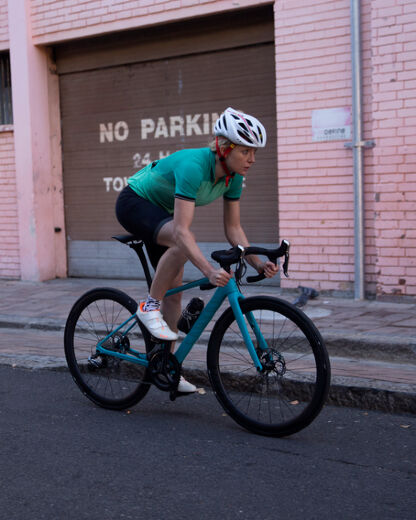
Road Bikes
Traditional road bikes can be used every day of the week if you set yourself up with the right gear. Though they may not be as comfortable as a hybrid bike, their skinnier tyres and more aerodynamic design is great for those who add some performance to their commute.
Road bikes are often the lightest bikes making them faster and a little more expensive. Carbon fibre is a common material for road bikes both for the frame and components. Drop handlebars offer varied hand positions, which some riders might prefer if their route is longer.
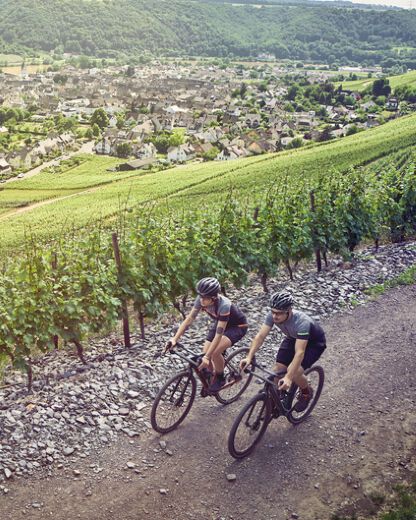
Gravel Bikes
In more recent years, gravel bikes have risen in popularity. Their ability to bridge the gap between rough terrain and smooth tarmac makes them the chosen bike for people whose commutes may feature gravel paths, traffic-free bike paths and city streets.
While gravel bikes look similar to road bikes, they have a slightly more relaxed geometry as well as wider tyres. If you want to enjoy more off-road cycling both during the week and at the weekends, a gravel bike could be your ticket to ride. Torn between a gravel bike and a road bike? We’ll help you decide.
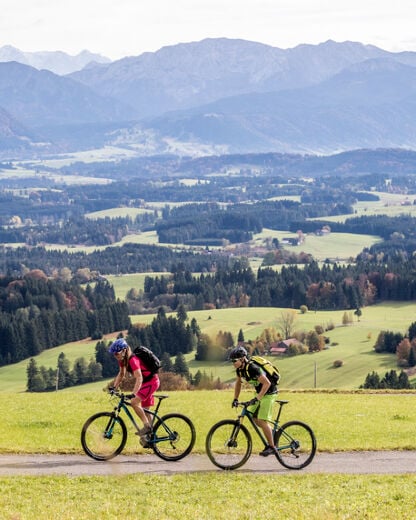
Mountain Bikes
Most people are unlikely to cross mountain ranges to get to work but that doesn’t mean they’re not good bikes for everyday use. Rough cycle paths are not uncommon for many people and if mountain biking is what you enjoy at the weekend, you may as well use it during the week as well. The great thing about mountain bikes is you’ll be able to go on the road less travelled and escape the busy main roads. Wider tyres and easier gears also make them great for hills.
Essential Clothing for Commuting
Cycling requires an element of practicality when it comes to clothing choices. While the odd trip across town can be done no matter what you’re wearing, it’s important you’re comfortable and dress for the weather.
With the development of commuting-specific clothing, you can enjoy the performance fabrics from the sporting side of cycling while looking stylish at the same time.
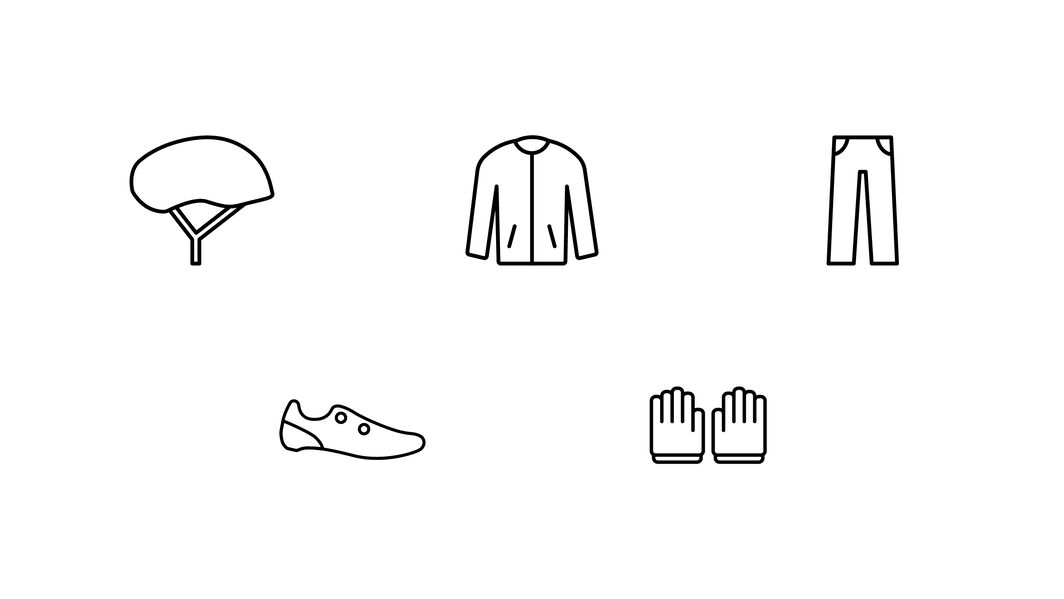
Helmets
In some parts of the world, helmets are mandatory so it goes without saying that you’ll need to get one before you can get in the saddle. That said, we recommend wearing a helmet regardless of local laws.
Helmets come in all shapes and sizes including some designed for city cyclists to match your commuter bike. These urban cycling helmets have small reflective details to make it perfect for before and after the daily grind.
Look for the MIPS logo for added protection. This technology reduces the risk of brain damage if you fall off your bike.
Waterproof Jacket
Don’t get caught out in the rain without a waterproof jacket. During a downpour it will keep your other layers dry and if the road is damp and mucky, you’ll stay clean too.
Layers are your friend when it comes to cycling and it’s never a bad idea to carry a waterproof just in case. Most commuter-friendly waterproofs have ample storage options for your phone, wallet or office pass, so you don’t have to fumble around outside for your keys.
Trousers, shorts or leggings?
The weather will mostly determine what’s practical for your commute that day. Some people prefer to wear cycling-specific clothing on the bike and change into their workwear for the day. Others prefer the ability to roll off the bike and into the office with no faff.
Commuting trousers are unlike most others with added stretch around the knees although you’d be hard-pressed to spot the difference between them and a standard pair of trousers. As well that, these trousers have neat reflective details on the hem to add extra visibility on the road.
If your commute is longer and more undulating, we’d recommend some proper cycling gear. It’s tried and tested by cyclists who spend hours (sometimes days!) in the saddle and there’s good reasons why. Padded shorts increase comfort over longer periods of time by preventing chafing and other discomforts. If you opt for traditional cycling gear, there’s no risk of your work outfit being covered in sweat and road grime.
Cycling shoes
If your commute is short, quick and relatively easygoing, a good pair of trainers will probably suffice. However if you want to use your commute as an opportunity to do a bit more heart pumping exercise, cleated shoes and pedals will provide more stability and greater comfort for the duration.
The debate between flat pedals and clipless pedals never ends however there are pros and cons to both and you should make the decision based on what works for you.
Sunglasses
Clear vision is important when you’re among traffic. As light conditions can vary throughout the day, it’s important to be able to see clearly no matter what. Cycling sunglasses will protect your eyes from harmful UV rays as well as any dirt that gets kicked up in front of you by other riders or motorists.
Gloves
Is there anything worse than cold hands on the bike? Probably not! It’s easy to be tricked by a bright shining sun on your way into work only to find there’s a freezing wind and you’re struggling to operate the brake levers.
Not only are gloves good insulators, but they also absorb road vibrations and protect your hands in the unlikely event you fall off. If your hands are important for your work, it’s crucial you protect them.
Cycling gloves are available in full-finger and fingerless options. We recommend getting a set of each for year-round protection.
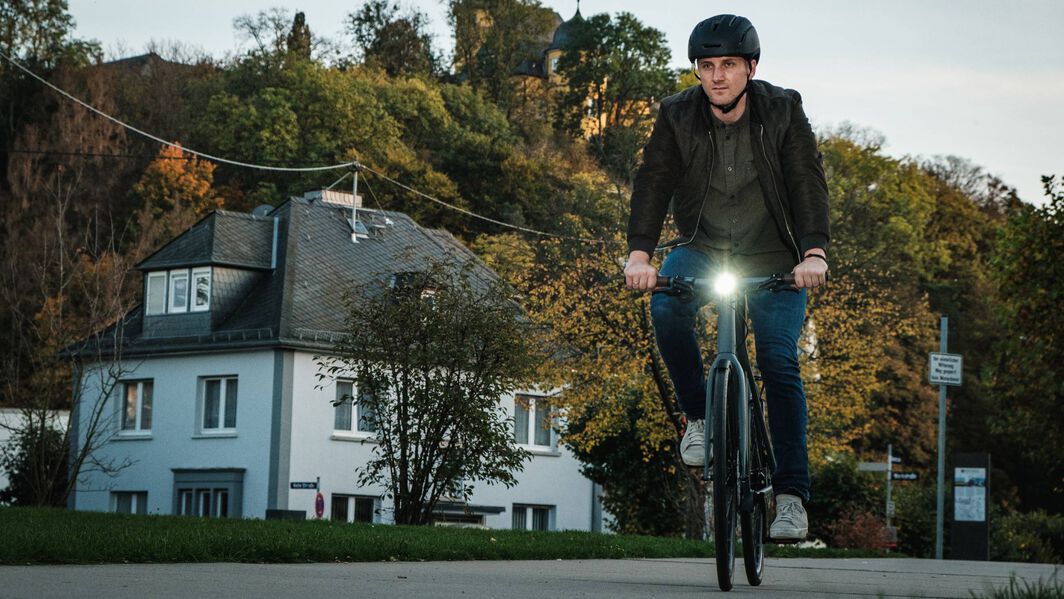
Must-have accessories for commuting
As soon as you’ve settled on the right bike, it’s essential you arm yourself with some necessary bits of kit that will make all the difference. Even if you commute just once a week, these accessories are crucial for enjoying your spin into work.
Lights
A good set of bike lights are always a good idea no matter what the conditions are outside. A static front light will help you see the road ahead, and an additional flashing light helps other road users see you. A similar setup on the rear of the bike will keep you visible from behind.
Most countries have laws that dictate the use of bike lights at night, so don’t be caught out.
Mudguards
If you buy a bike without built-in mudguards, the good news is they’re easy to fit afterwards. A good set of mudguards will attach to your fork at the front and your seat stays at the back. Long after the rain has passed, the roads will be greasy, wet and full of dirt especially near the curb of the road.
Bike bags
A backpack is the minimum you need to get to work complete with all your belongings. Whether you’re carrying spare clothes, your lunch or your laptop, a high-quality backpack is an absolute must.
Pannier bags are a great alternative if you want to keep your body free of any heavy loads. They’re a great idea if you decide to pick up some shopping on your way back home, too. Be wary of loading them up too much as they can affect the balance of the bike.
If you plan to use panniers, you need a bike that has rack mounts such as the Canyon Commuter. When you first load up the bike with everything, make sure you go for a little spin around the block to ensure the bike is well balanced. Tip: try to split the load between the two sides of the bike for a smooth ride.
Bike bags are great for bikes that don't have rack mounts such as the Canyon Endurace. Some people prefer to use the same bike for all trips and bike bags make it easy to do so. Again, make sure your bags aren't so heavy that they touch the rear wheel. Tighten the straps to avoid the bag swinging from side to side and you're good to go.
Bike lock
Better safe than sorry, as they say. A good bike lock is essential, especially if your workplace doesn’t have secure bike parking. Even then, your bike may not be safe from the prying eyes of would-be thieves.
Even if you leave your bike unattended for a couple of minutes, we recommend locking it up. Stealing a bike doesn’t take long! We’ve delved deeper into this topic with our top tips for bike security.
Planning your route
The way you would drive into work is unlikely to be the best way to get there by bike. Certain roads restrict bikes and even if they don’t, some roads are just too busy and dangerous for cyclists.
With that in mind, it’s time to take a closer look at the map.
Use bike lanes where possible
The dramatic rise in the number of cyclists on our roads means governments and councils are improving and investing in infrastructure. Even the COVID-19 Pandemic prompted heavy investment in cycling in many countries and as a result we’ve seen a boom across the world of people getting on their bikes for the health and fitness benefits. By using segregated cycleways, you’ll be riding your bike away from cars, lorries and other motor traffic on the most direct routes into and out of the city.
Traffic-free cycle network
More detailed maps show more than just roads. Bridleways, traffic-free cycle paths and canal/river paths are often safer, more enjoyable and sometimes quicker than roads without all the busy junctions. Make a note of the road surface and give them a try. You might find you can take a more scenic way into work in the morning.
Look for smaller roads
Where you can’t avoid riding in traffic, find alternatives. Quiet roads that run roughly parallel with busier arterial rat runs are a great option. Though the distance may increase, you’ll have a much nicer time on two wheels by avoiding the stress of negotiating traffic at rush hour.
Useful skills for commuting
Cycling is not without its perils. Just like you can breakdown in your car or on the train, so too can bikes. The good news is most breakdowns are avoidable and easily repairable when you know how.
M-check your bike
The quickest and easiest way to make sure everything is in full working order before leaving the house is to do a quick m-check.
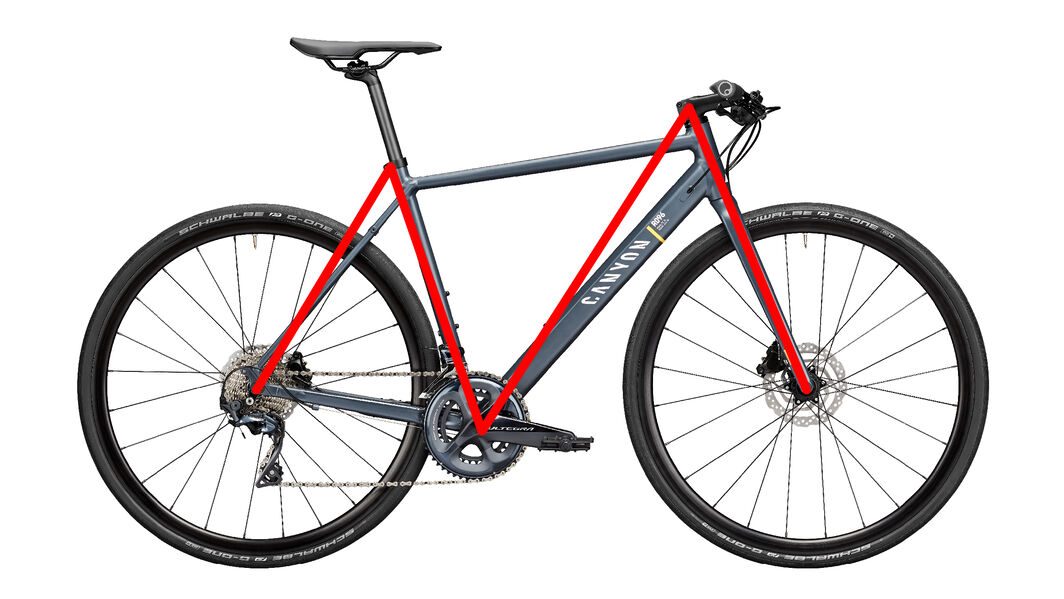
Starting with the rear wheel, check the brakes are working and that the wheel is secured. While you’re there, check your tyre is pumped up. Next, check your saddle is clamped properly and there’s no movement there. Moving on to your chainrings and pedals: give the pedals a quick spin and make sure your chain is free of heavy grease and grime. After that, check the stem and handlebar. Ensure they’re aligned properly and the front wheel points in the same direction as your handlebar. Finally, perform the same brake and tyre check on the front wheel as you did on the rear and make sure the thru-axle or quick release skewer is properly tightened.
Learn to fix a flat tyre
No amount of money in the world can free you from the perils of flat tyres, so it’s important you learn how to fix one on the go. They’re inconvenient and will mean a few minutes on the side of the road but it’s the only way to safely get back on the road again.
Always carry a repair kit consisting of a spare tube, a mini-pump and some tyre levers when you’re on your bike. If it turns out to be unfixable, make sure you befriend your local bike shop who can get you up and rolling again in no time.
Follow the rules of the road
Before your first commute, familiarise yourself with the laws of riding a bike on the road and follow them. Stopping at red lights and riding in the same direction as the traffic are some obvious ones. Also take note of signposts that will help you navigate city centres. While some roads are prohibited to motor vehicles, they’re great traffic-free roads for cyclists.
Remember to give way to pedestrians on shared-use paths and avoid blocking pedestrian crossing when you’re stopped at lights.
Freshen up when you arrive
Some workplaces are good enough to provide showers, lockers and a secure place to keep your bike while you work but others fall short. If your commute is likely to break a sweat, make sure you have everything you need to feel fresh before you see your colleagues.
Wet wipes, deodorant and a spritz of cologne or perfume go a long way in making you feel clean and masking any unpleasant odours. If you know your commute will make you sweaty, your best bet is to have a change of clothes when you arrive. If it’s possible, you can keep a few items in your desk drawer so that you don’t have to carry them with you every day.
Ready to ride
When you have your bike, clothing and accessories sorted, it’s time to head out. Allow for a bit more time than you think you need in case of the unexpected (or a cheeky coffee stop on the way in!) and enjoy the freedom of riding a bicycle.
Discover our Hybrid Bikes
Did this article help?
Thank you for your feedback
